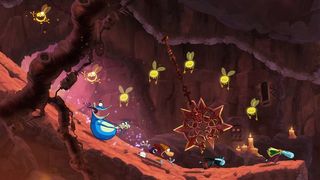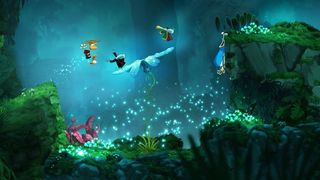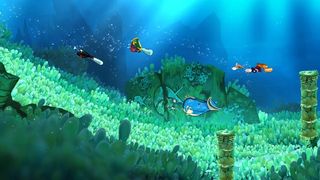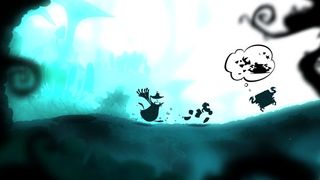Rayman Origins extended hands-on preview
We go solo through the first half of 2011's prettiest platformer
Whether or not Rayman Origins actually stands a chance in hell when it arrives in stores next month remains to be seen, but judging by what we’ve played so far, it certainly deserves to. It’s vibrant, fast and beautifully animated like few other games out there, 2D or otherwise. It’s also surprisingly fun, with inventive, cleverly designed levels that range from quick, easy romps to crushingly difficult speed runs. Most importantly, though, it has an “OK, just one more level” appeal that sucked us in and kept us playing for hours longer than we intended.

Above: This giant bird boss will also suck you in. Seriously, stay away from that beak
That may be too generous for a preview. We’ve only been able to play through about the first half of the game, after all, so it’s entirely possible that Origins turns to crap right after that. Possible, but unlikely.
Origins is pretty light on story, so here it is in a nutshell: Rayman and his friends (including a creator deity known as the Bubble Dreamer) snored too loud and pissed off some underworld dwellers known as the Livid Dead. Not content to cage Rayman and co., they also rounded up all the Electoons – little pink creatures that apparently help the Bubble Dreamer maintain his sanity – and hid them in cages around the game world.
Above: You know what, we'll just show you Origins' intro movie and let you figure it out
To find them, Rayman, his toadlike friend Globox and an assortment of little hangers-on known as the Teensies (you can play as whichever ones you like; all have the same abilities) will have to charge through a wide variety of 2D stages, smashing enemies, dodging environmental hazards and collecting Lums, little floating creatures that can unlock bonuses if you grab enough of them. They’ll also hunt for little secret nooks and passageways that hide skull coins (needed to open the way to the game’s final stages) and Electoon cages (which are always guarded by enemies in some kind of puzzle room).

Each stage, as a rule, hides three Electoon cages, which are pretty easy to find; you’ll know you’re nearby when you hear a squeaky little voice yelling for help. It’s a constant in nearly every stage we visited, lending a little bit of comforting stability to the otherwise diverse stages. That kind of consistency also crops up across the overall structure of the game. For example, each of the “worlds” we played through begin with a level where you’ll have to free a buxom fairy from a cage (which will try to run away from you). Once freed, she’ll grant you a new power, like the ability to attack, float, shrink, dive underwater or run up walls. That power then factors pretty heavily into the following stages, which culminate with a bonus level and flying shooter stage (often with a boss fight) that bridge the world you’re in with the next one.
Sign up to the GamesRadar+ Newsletter
Weekly digests, tales from the communities you love, and more

Above: Also, you can absorb an extra hit by grabbing a floating heart. Here's one's face exploding into halves
We tackled five worlds in all, beginning with the Jibberish Jungle, a green-tinted training ground filled with cliffs,caves and waterfalls, and moving on to the music-themed Desert of Dijiridoos, which was filled with super-windy areas that forced us to float through spiny, floating blowfish.

Next came Gourmand Land, which was food-themed and alternated between arctic ice floes (with giant hunks of watermelon and lime thrown in for good measure) and jalapeno-filled magma kitchens. After that was the Sea of Serendipity, with giant eel bosses, monster-filled underwater caves and occasional seaside villages. Finally, we visited Mystical Pique, a mountaintop retreat filled with bearded monks and plenty of curved walls to run up.

Above: And golems. Lots and lots of boulder-throwing golems
It all makes for a fun item-hunt that lets you hammer the jump and attack buttons a whole lot. In the main, though, it’s not especially challenging; the Electoons are always easy to find, the enemies almost all go down with one hit, and most obstacles are easy to get around if you know what you’re doing.

If a good, stiff challenge is what you really want, however, you’ll want to keep an eye out for the “chest chase” stages. These ratchet up the difficulty to absurd levels, forcing you to follow a living chest that rapidly scrolls the screen right and killing you instantly if you fall behind. At the same time, you’ll have to contend with obstacles and enemies that spring up suddenly, meaning that success comes only with perfect memorization and timing (or lots of luck), with no room for error.

Above: Much tougher than it looks
Played the way it’s intended, with four players onscreen at once, Origins can be wildly enjoyable. Chaotic and often confusing, sure, but still fun. However, and in spite of creator Michel Ancel’s stated disinterest in making Origins a single-player game, the solo experience might be where the game’s real appeal lies. When playing alone, for example, the camera zooms in close enough that it’s much easier to appreciate just how good everything looks. And without the confusion of trying to figure out which flailing onscreen character is you, it’s possible to better appreciate and understand each level’s design.

Add to that an insanely catchy soundtrack, a handful of neat tricks to squeeze more Lums out of every level, a cast that speaks almost entirely in Pig Latin and a big assortment of (similarly shaped) characters to unlock, and Rayman Origins is shaping up to be something tremendous for fans of 2D, old-school platforming. Whether that can draw attention away from the likes of Skyrim and Modern Warfare 3 when Origins launches on Nov. 15 is anyone’s guess, but here’s to hoping it doesn’t get lost in the holiday shuffle.
Oct 17, 2011
Most Popular



